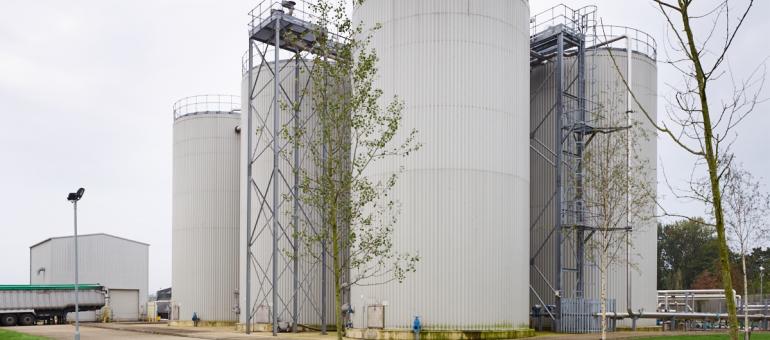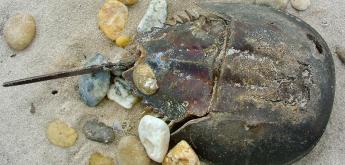Digging Deeper into Anaerobic Digestion

One of the best tools we have to battle climate change and global warming is the generation of energy from wastewater byproducts and food waste. Facilities in the United States produce 4.5 million dry metric tons (mdmt) of treated sewage sludge or biosolids annually. 42% of that material goes to landfills. Additionally, the U.S. Department of Agriculture (USDA) estimates that in 2010, 31%, or 133 billion pounds, of the 430 billion pounds of food available at the retail and consumer levels was not eaten.
Anaerobic digestion is a biosolids treatment method that uses bacteria to transform organic waste into energy without oxygen. This transformation occurs naturally in marshes and has been recreated in closed tanks called digesters to make it available on a larger, more controllable scale to treat wastewater.
The bacteria digest the organic fraction of the waste and convert it into biogas, a renewable energy source. The residual organic matter forms a digestate that is dewatered, composted, and used as a fertilizer by farmers.
Veolia Water Technologies & Solutions promotes the local production and use of renewable energy and has empowered clients to make the most of this sustainable solution. For example, Veolia played a role in France’s Artois compost site, which generates about 3.5 million cubic meters of biogas and 25,000 tons of treated waste per year. The treated waste allows the production of 8,000 megawatt hours of electricity, equivalent to the annual consumption of 2,700 households. The 7,000 tons of organic matter that do not decompose during the anaerobic digestion process each year are reused as compost by local farmers.
To learn more about anaerobic digestion, let’s look at some frequently asked questions on the topic.
Q: What are the main benefits of anaerobic digestion?
A: The biggest benefit to society of anaerobically digesting organic waste is ensuring biodegradable material never makes it into our landfills where it would otherwise release methane to the atmosphere and liquid leachate runoff, contaminating our waterways and groundwater.
By diverting organics to anaerobic digestion systems, we can:
- Produce renewable energy from traditional waste products
- Offset and replace chemical fertilizers in our agriculture industry
- Prevent methane (a potent greenhouse gas) from being released into the environment uncontrollably
- Reduce and divert solids that typically go to landfills
Anaerobic digestion also optimizes hydrolysis and acidification for wastewater treatment facilities, enhancing biogas production. This can increase throughput by 200-300% over traditional digestion, which was exactly the case with Anglian Water’s Great Billing Water Recycling after implementing our technology.
Q: What does an anaerobic digester system look like?
A: In its simplest form, an anaerobic digester system involves a sealed tank to prevent oxygen from getting in and biogas from getting out.
It is heated to a temperature similar to the human body and mixed well. The organic material is fed into the tank where it is held for 15 to 20 days, which is sufficient time to allow anaerobic bacteria to convert the carbon-rich organic matter into biogas (~60% methane). That methane-rich biogas can then be utilized to generate electricity from a combined heat and power unit (CHP) or scrubbed to remove impurities, upgraded, and injected into the natural gas grid where it is eventually sent to our homes and businesses that use gas for heating and cooking.
Q: How does anaerobic digestion play into the circular economy?
A: Anaerobic digestion brings two key pieces to the circular economy: Renewable energy and nutrient recovery.
By utilizing the biogas from anaerobic digestion plants to generate renewable energy (especially in industries that are difficult to electrify) we can offset fossil fuel consumption and hopefully keep those fossil fuels in the ground. Crops take carbon dioxide from the atmosphere and convert it to energy in the food we eat. After passing through the human consumption cycle, that material still has a lot of leftover energy in the form of carbon that we can capture in the biogas from anaerobic digestion systems.
Most, if not all, of the feedstock for anaerobic digestion systems comes from agricultural land. Farmers need to replenish the soil that grows crops with carbon nitrogen and phosphors to ensure that land remains productive. Anaerobic digestion plants produce a digestate that can eventually be spread on the fields to return these nutrients and healthy microbes to the land and limit the need for chemical fertilizers.
Q: Are there misconceptions about this process or any claims you think should be debunked?
A: We need to overcome the “yuck factor” when dealing with organic waste. This process happens naturally in landfills, so it is to our benefit as a society to take these waste products and capture their energy in an engineered solution.
Odor issues are one of the biggest concerns when building these facilities. However, odors can be eliminated and there are examples of successful facilities in or near urban environments.
Q: How does Veolia fit in?
A: Veolia offers a complete suite of anaerobic digestion solutions like feedstock preparation, tank mixing and heating solutions, digestate separation and treatment, biogas conditioning and upgrading, and managed operations of these facilities.
Learn more about Veolia’s anaerobic digestion system enhancement capabilities or contact an expert.







